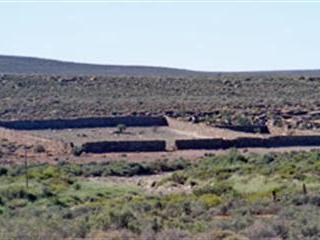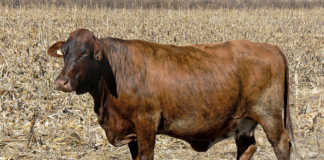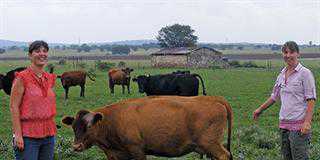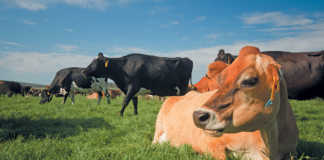
Risk is the probability that an out-of-theordinary event, involving a loss, will occur. Farming risks should be identified, measured and managed to minimise their impact. Farmers tend to focus on risk management but many problems can
be avoided by identifying and measuring the extent of the risk. Risk factors in farming include the weather, the economy and socio-political factors.
Despite major advances in meteorological science over recent years, the weather remains stubbornly unpredictable. Gambling on the weather is therefore part of a farmer’s life and he learns to deal with it. But despite fodder banks and stored water, the lurking possibility of drought invariably strikes fear into the heart of a rural community.
FIRST SIGNS OF DROUGHT
Drought does not start when the grazing is finished. It may begin with late-onset rain and continue with long intervals between showers, or there could be a long interval between early first rain and follow-up rain. It is commonly known that droughts lasting for three to four years occur every eight to 10 years.
Not so well known is the fact that dry spells can occur during a wet cycle. Factors that a farmer can control include grazing management, stocking rate, marketing strategy and early decision-making. Environmental conditions, which are largely out of the farmer’s control, affect production, yield, dry matter availability, and animal health.
CONSERVATIVE GRAZING MANAGEMENT
Sound grazing principles are more important than particular grazing systems. Good natural veld is productive, palatable, and stable. Grass growth on veld occurs for about four months of the year. This gives the veld its productive capacity for the season. It is absolutely vital that veld is rested periodically. Rest during winter, however, does not really help the veld, which is in a state of natural rest at this time anyway. To benefit, grass needs to be rested during its period of active growth.
Whether high pressure grazing, quick rotations or continuous grazing is used, the effect on veld condition will be negligible. The major influence comes from managing the seasonal rest of the grass. If part of the veld receives rest for the entire season, that grass will maintain a high level of production. With resting strategies in place, it is easy to gauge the veld’s production level. When animals are restricted to a section of the veld during the growing season, the rate at which grass is used will give a fair indication of the balance between carrying capacity and stocking rate.
CAREFULLY PLANNED MARKETING
A flexible approach to marketing will complement a conservative grazing management system. This focuses mainly on marketing older, rather than freshly weaned, animals. The pros and cons of each system must be carefully considered.
Converting to marketing later in the animal’s life can have serious cash flow implications. Weaner income will fall away and any animals held back must be supplemented during winter. There is a risk that an animal may be lost during the period from weaning to marketing.
On the other hand, if animal numbers must be reduced because of drought, this can be done without a drastic reduction in breeding stock. For example, to reduce the stocking rate of a 100 LSU herd by 20%, a total of 10 to 15 cows will have to be sold if the production system is marketing weaner calves.
If 27-month-old steers are ready to be marketed, only the 18-month-old animals need to be added to their number. In Table 1 the production and income potential of a weaner system is compared with a system in which animals are marketed at 27 months. Although the longer growth production system seems to produce more marketable liveweight, the gross income does not differ appreciably.
ASSESSING
An early warning system is only useful when inputs are linked to outputs or reactions to results. Feedback from the grazing system channelled into the early warning system must result in a predetermined reaction to the marketing system or to animal feeding management.
As a rule of thumb, grass production on the veld can be assessed by mid- December. Monitoring veld can involve cutting, drying and weighing dried samples or simply recording the time spent grazing a camp. If production is down, a pre-determined action should be taken.
Weaners or steers could be marketed earlier, for example, or fodder brought in. Prompt reaction to information-gathering ensures that a farmer can acquire fodder or sell livestock ahead of the rush and manipulate the situation to his economic advantage.
BALANCE ANIMALS AND FEED
In a serious drought, production will play second fiddle to survival. The first thing to do is to balance the number of animals with the feed available. Table 2 provides dry matter (DM) guidelines for maintenance requirements and external parasites vigorously, as animals held in small, confined camps will be more prone to parasitic infestation.
Usually, animals need to be fed from the time the grazing is finished until about two to three weeks after the onset of the rainy season. This period seldom exceeds three to four months. Selling breeding cows is not a good idea, as they will probably fetch poor prices and the price of breeding stock will rise with declining availability.
A drought provides an opportunity to rid the enterprise of tail-end cows, such as those with the longest intercalving periods and lowest milk production. Keeping good cows through a drought will be expensive, but less so than buying in new animals when the drought is over. Heifers are smaller and need less feed than mature cows so if fodder is really limited, more heifers can be kept through a drought than cows.
FEEDING STRATEGY
Cattle and sheep are ruminants and need fodder to survive. In tough times, quality is less important than quantity. Most deficiencies can be fixed from a bag, and feeding companies have supplements for low quality roughage that can be mixed with grain to enhance the nutritional value of the ration.
There should be enough feeding space to allow less dominant animals a chance. Troughs should be scattered in a shotgun pattern with at least 10m between troughs for cattle. Although non-productive animals can be maintained at survival nutrition levels, pregnant and lactating animals must be fed according to their production.
WHEN THE DROUGHT BREAKS
The advent of the rain does not bring instant relief to drought-stricken veld. So it is best to avoid putting animals back on the veld for at least two weeks after the rain has started. Sheep should be particularly well-managed when they return to green grass after a long period of eating dry feed.
It is advisable to vaccinate them against pulpy kidney to prevent mortalities resulting from dietary changes. Grass staggers, a disease caused by magnesium shortage, can occur when animals go back onto green feed.
SURVIVAL AND BELIEF
The costs and the consequences of drought must be faced squarely and practically if a farmer is to survive a serious drought. The proactive implementation of previously planned strategies can increase the chances of navigating successfully. Correct drought management strategies will help the producer to get back to capacity in a reasonable time. Above all, stay positive and focus on getting through.
The rain will come.
Email Izak du Plessis at izak. [email protected].













